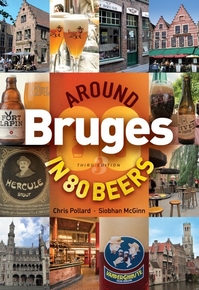In Bruges: for beer, bars and a brewery
Added: Thursday, February 7th 2013
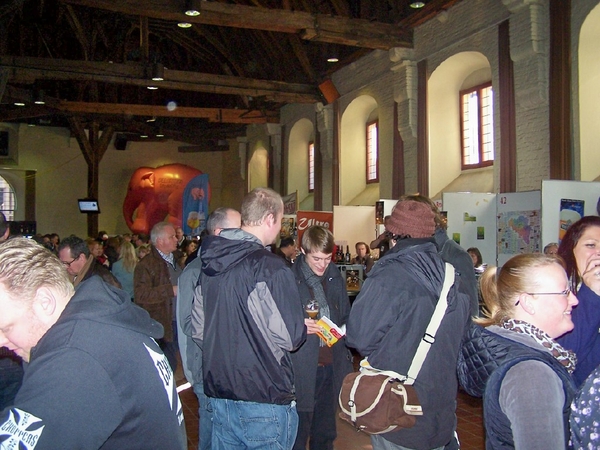
The 2014 Bruges Beer Festival takes place in January. I went with Beer Junkets (see ad on this site) and the company is highly recommended.
Is there a finer setting for a beer festival than the Belfry in the central square in Bruges? The Belgians – rightly -- take their beer seriously and they give it the setting it deserves in the grandeur of the bell tower. It dates from 1240, bestrides the Markt – the market square – and stands like a beacon across the flat lands of Flanders.
The annual festival is organised by BAB, the Brugse Autonome Bierproevers, the Bruges branch of the national beer drinkers’ organisation, Zythos. The Belfry stands 83 metres high and its beamed and raftered rooms offer a magnificent backdrop to the 300 beers on display. It’s remarkable that a relatively small country can produce such a vast number and range of beers and they are given due respect in the Belfry.
There’s even space for one beer from abroad: the La Trappe ales from the abbey of Koningshoeven in Tilburg, just across the border in the Netherlands. They join beers from the six Trappist breweries in Belgium that keep alive a brewing tradition that was lost in most countries when religious houses and their breweries were dissolved.
The 2013 festival is over but it’s worth planning a visit in a year’s time. The 2014 event has already been booked and will run on 1 and 2 February next year: you can follow the plans and the countdown to the festival on www.brugsbierfestival.be. The organisers say that visitors from 35 countries regularly visit the festival and I found not only familiar faces from British beer festivals but also drinkers from the United States, Germany, the Netherlands and even Australia. The last-named were determined to live up to their stereotype, draped in their national flag, wearing corked hats and carrying toy kangaroos.
The festival is meticulously planned and organised. The entrance fee is a modest 7 euro and the number of drinks you have depends on the jetons or red buttons you buy: one jeton gets you a beer in a festival glass.
The programme details the brewers’ stands and the beers on offer. Belgium’s beer styles are described in fine detail and you will be able to follow a trail that leads from the ground floor, across a cobbled courtyard and up to the main room with its soaring rafters where the biggest number of beers is on offer.
Helpfully, the programme lists all the new beers available that year. I was amused to find a beer called Adolph Sax that commemorates the inventor of the saxophone and I was drawn to the stands where Verzet had a memorable stout aged in whisky barrels while Vliegende Paard Brouwers launched a No Hops No Glory ale, with the beer delivered through a glass tube packed with fresh hops.
There are familiar names and styles, including lambic and gueuze, sour red, fruit beer, golden ale, saison and wheat. But Belgian brewers are not resting on their laurels and new styles are appearing, including American-style IPA and Imperial IPA and a growing number of beers – both light and dark – aged in wood derived from both the whisky and wine industries.
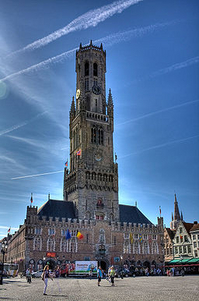
Bruges is a daily beer festival and you don’t have to wait until 2014 to enjoy the pleasures on offer. Just a few minutes’ walk from the Markt along Steenstraat brings you to one of the world’s greatest bars, ‘t Brugs Beertje or Little Bruges Bear at 5 Kemelstraat. It’s best known to British visitors as “Daisy’s Place” where owner Daisy Claeys has an amazing beer list of 250 Belgian ales, served in two small comfortable and cheery rooms. If a bar can be a hymn, then Daisy’s is a religious chant to great beer.
When the two rooms are filled to bursting, Daisy will open the function room at the back. This is an area of historic importance for it was here in 1985 that two beer lovers decided to tell the world about the joys of Belgian beer. The event was a beer tasting organised for a group of British journalists and CAMRA members and the group included Michael Jackson and Tim Webb. Michael was already an acclaimed beer writer while Tim, a CAMRA activist, had taken time out from his work in the NHS to run the Great British Beer Festival. They were sufficiently enthused by the beers they sampled that evening to plan their ground-breaking books – Michael’s the Great Beers of Belgium and Tim’s Good Beer Guide Belgium.
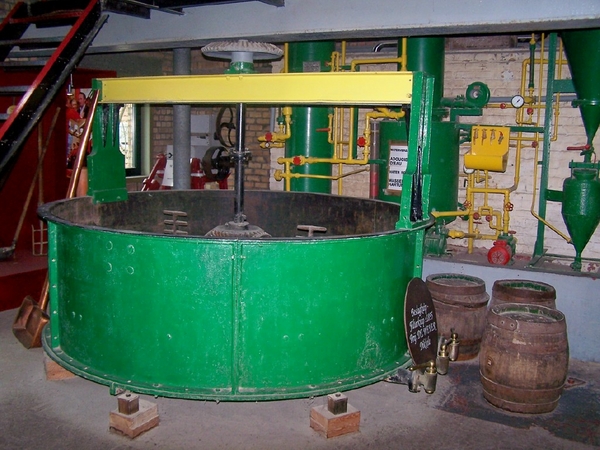
Bruges may have magnificent medieval buildings, canals, and market squares of jaw-dropping beauty... but no breweries. Surely one of Europe’s great trading cities in a country where beer is deeply locked into history and culture must have breweries.
It had 20 or more at the start of the 20th century. But mergers and takeovers took their toll. And big brewers concentrated on lager, universally known as Pils in Belgium.
The last brewery in Bruges was Straffe Hendrik. It became part of the Riva group and the Straffe Hendrik brands were moved to the group’s main plant in Dentergem in the 1980s. When I was invited to tour the brewery site during the festival weekend I thought I was going to view a museum. Imagine my delight when I discovered that brewing has restarted and is back in the hands of the original family owners.
The brewery, now called De Halve Maan, the Half Moon, was founded in 1856 by Henri Maes and it’s his descendants, the Vanneste family, who have restored brewing at the site. The ground floor is occupied by functional enclosed 1960s vessels but the visit just gets better and better as you clamber up narrow stairs and walkways. Here are old wooden brewing vessels with, under the roof, a copper cool ship, an open vessel where beer used to ferment at ambient temperature.
De Halve Maan has won the right to brew two Straffe Hendrik beers, Tripel (9%) and Quadrupel (11%). It’s good to see them back but the main point of interest lies in the two house beers designed by the Vanneste family and based on 19th century recipes.
They are Brugse Zot Blond (6%) and Brugse Zot Dubbel (7.5%). Zot is a Flemish word meaning fool and the beers take their name from an ancient Bruges legend. It seems the city had more than its fair share of mentally ill people in the 15th century and the citizens lobbied the Austrian emperor Maximilian to build an asylum that would be called the Fools’ House. The emperor waved a dismissive hand and declared: “Just close the city walls – Bruges is full of fools”.
The fools have had the last laugh. Blond has met with great acclaim and won a gold award in the World Beer Cup in the U.S. It’s brewed with pale and Munich malts and hopped with Czech Saaz and Styrian Goldings. It has a pale bronze colour with a big spicy hop aroma balanced by cracker-like grain and a strong hint of butterscotch. Citrus fruit builds in the mouth, balanced by rich honeyed malt and increasing hop bitterness, followed by a dry finish with tart fruit, ripe grain and bitter, spicy hops.
Amber and chocolate malts are added to pale and Munich for the Dubbel. It has a deep russet colour with spicy hops and toasted malt on the nose with notes of burnt dark fruit. The palate is packed with vinous fruit, roasted grain, caramel and bitter hops, while the complex finish is dry and hoppy, overlain with roasted malt and fruit.
The brewery at 26 Walplein has a shop, bar and restaurant. Tours can be booked: www.halvemaan.be.
De Halve Maan doesn’t brew lager and it’s not sold at ‘t Brugs Beertje. Daisy Claeys would no doubt agree wholeheartedly with the tour guide at the brewery who says: “In Belgium, lager is for children.”
*For other recommended Bruges bars see the sixth edition of Good Beer Guide Belgium, £14.99, available from www.camra.org.uk.
*I travelled with Beer Junkets: www.beerjunkets.com. BEER JUNKETS are now taking bookings for the BAB 2014 festival -- refer to website/advert.
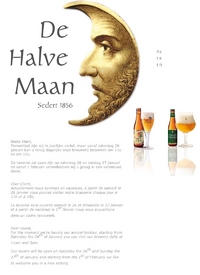
The definitive guide to drinking in Bruges
Around Bruges in 80 Beers, Chris Pollard & Siobhan McGinn (Cogan & Mater, £9.99)
Can there really be 80 outlets for good beer in this tiny town? “Podge” Pollard and Siobhan McGinn have found them in the third edition of their seminal guide. They have pounded the pavements, careened over the cobblestones and left no glass un-emptied in their quest for outlets that serve the finest that Belgian brewers can offer.
It’s a guide that wears its heart on its sleeve: “If it is lager and chips you are after, put us down and move on, as we will be no use you,” the duo state firmly in the introduction. In short, it’s a stellar book but not for Stella drinkers.
As someone who finds it difficult to leave Daisy’s bar, I must make a greater effort on my next trip to follow in Podge’s and Siobhan’s footsteps and take out some of the outlets they have discovered. I use the term “outlets” deliberately, for this is more than just a pub guide. It covers restaurants, De Halve Maan’s brewery and museum, beer shops, hotels, a boat and even a book shop that sells beer – Waterstone’s take note.
As well as the listings, the guide is helpfully broken down into the different categories of outlets. This means that when your stomach rumbles you will know where you can eat as well as drink. On my recent visit, I passed Bron in Katelijnestraat and had no idea it was a vegetarian restaurant that sells the sublime beers from Dupont, including the impeccable Saison. I shall not make the mistake again.
Helpfully, the guide lists the main types of dishes you will find in Bruges restaurants – I discover that sea bass is called zeewolf, which is rather alarming, while monkfish is sea devil: I’ll stick to pannekoeken or filled pancakes. For the first-time visitor, Podge and Siobhan also run down the main Belgian beer styles, so you can sort your Dubbel from your Tripel and will never mistake an abbey for a true Trappist.
As with all Cogan & Mater guides (proprietor Tim Webb of Good Beer Guide Belgium fame), the book is also shot through with a dry and acerbic wit – or witte, if you prefer. It’s excellent value for money and handsomely designed by Dale Tomlinson, who enjoys a glass or two himself.
Don’t catch Eurostar without it.
www.booksaboutbeer.com
